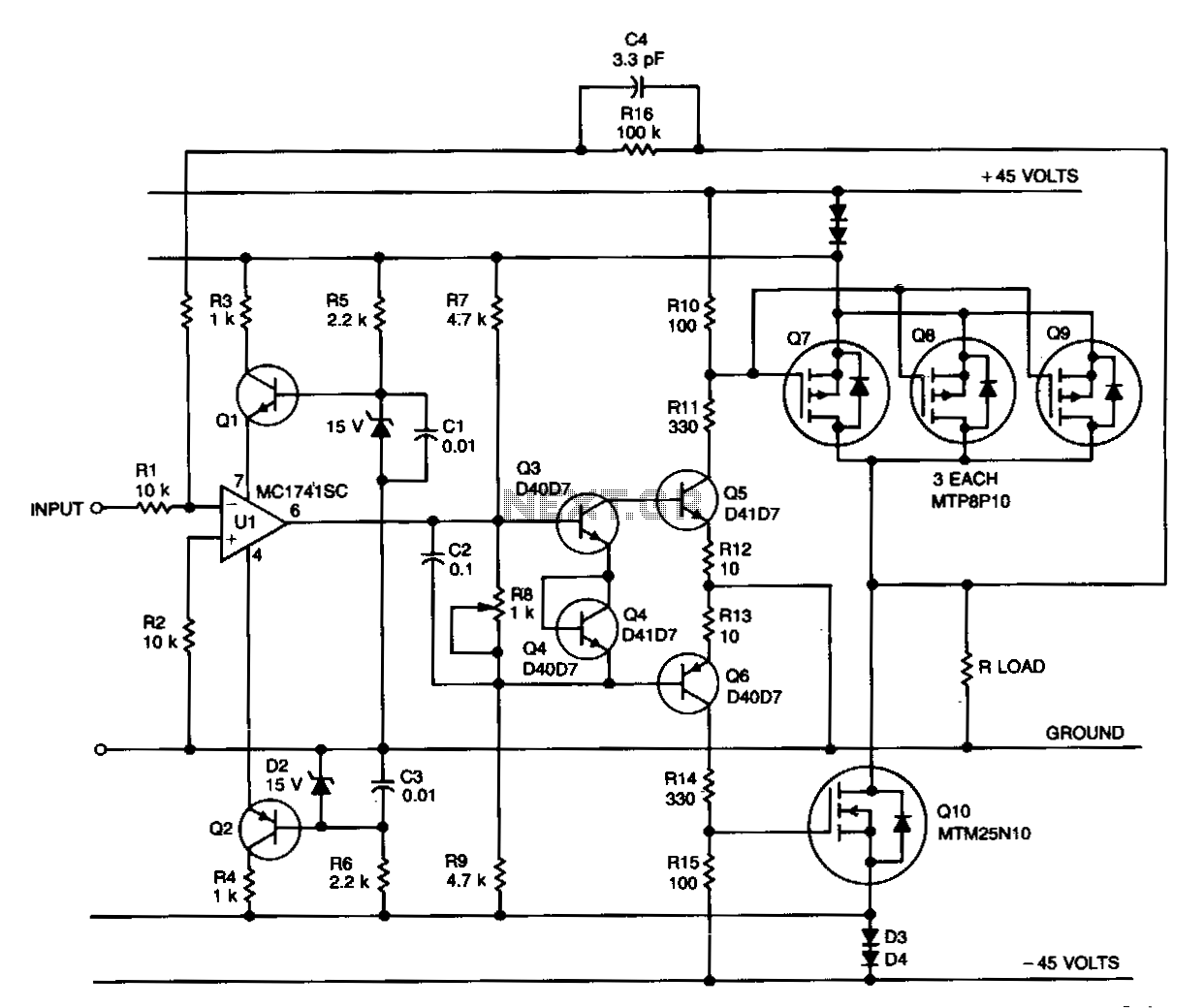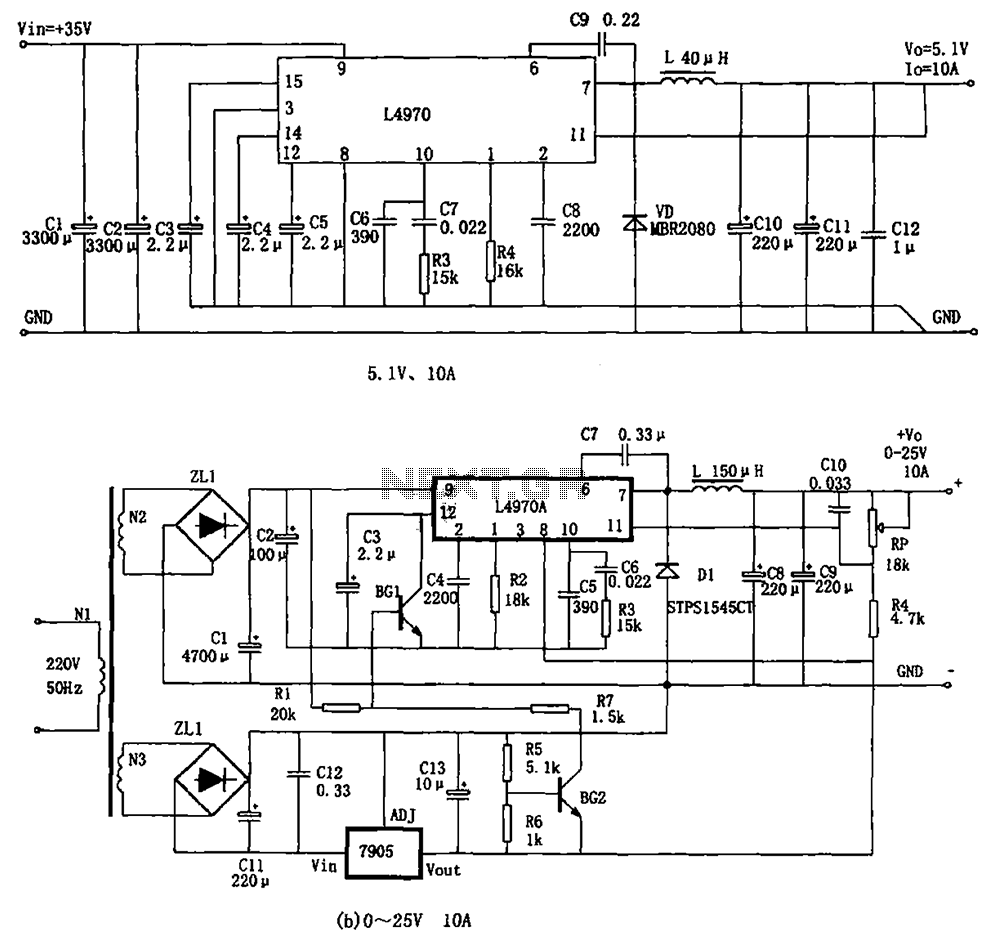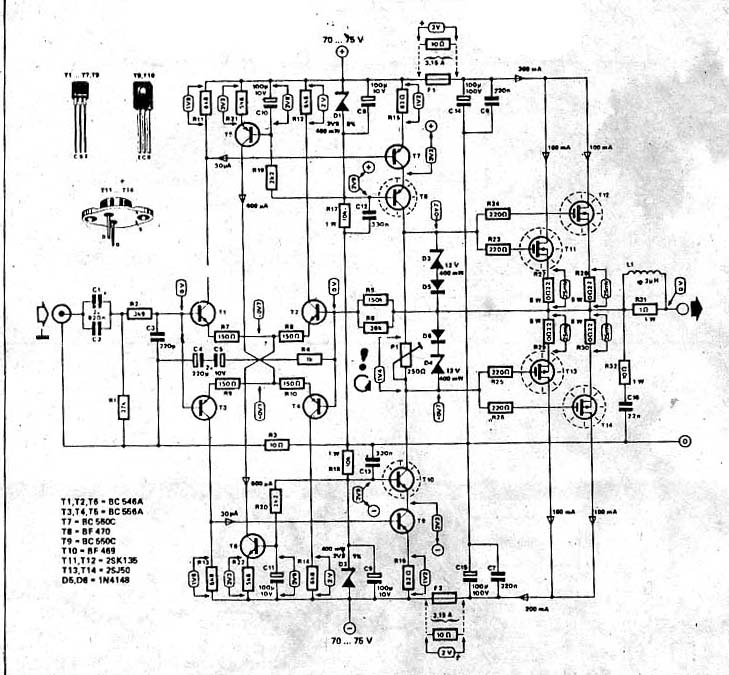
5V 0.5A power supply

The circuit functions as a constant voltage source, modified by feedback components R2 and R3 to maintain a stable output voltage. The ZN424E output must be at least 2 volts above the negative rail, with the load connected to the collector of the output transistor Tr2. The current configuration is established using transistor Tr1 and resistor R5. Performance characteristics of this simple circuit include: output noise and ripple at full load of 1 mV RMS, load regulation from 0 to 0 A at 0%, a temperature coefficient of ±100 ppm/°C, and a current limit of 0.5 A.
The circuit operates as a linear voltage regulator, leveraging the ZN424E integrated circuit to provide a stable output voltage. The feedback components, R2 and R3, play a crucial role in ensuring that the output voltage remains constant despite variations in load conditions or input voltage fluctuations. This feedback mechanism adjusts the base voltage of the output transistor Tr2, which acts as a pass element, allowing for efficient regulation of the output voltage.
Transistor Tr1, in conjunction with resistor R5, forms the initial stage of voltage regulation. The configuration ensures that the ZN424E maintains its required output voltage by adjusting the current flowing through Tr2 based on the feedback received from the output voltage. The load connected to the collector of Tr2 experiences a regulated voltage, which is critical for applications requiring precise voltage levels.
The performance metrics indicate that the circuit is highly stable, with minimal output noise and ripple, making it suitable for sensitive electronic applications. The load regulation of 0% signifies that the output voltage remains unaffected by changes in load current, which is an essential feature for maintaining consistent performance. The temperature coefficient of ±100 ppm/°C indicates that the output voltage will only vary slightly with temperature changes, enhancing the reliability of the circuit in varying environmental conditions. The current limit of 0.5 A ensures that the circuit can safely handle loads without risk of damage or failure. Overall, this circuit design exemplifies effective voltage regulation through careful component selection and configuration.The circuit is essentially a constant source modified by the feedback components R2 and R3 to give a constant voltage output. The output of the ZN424E need only be 2 volts above the negative rail, by placing the load in the collector of the output transistor Tr2.
The current circuit is achieved by Trl and R5 This simple circuit has the following performance characteristics: Output noise and ripple (full load) = 1 mV rms. Load regulation (0 to 0 A) = 0%. Temperature coefficient — ± 100 ppm/°C. Current limit = 05 A.
The circuit operates as a linear voltage regulator, leveraging the ZN424E integrated circuit to provide a stable output voltage. The feedback components, R2 and R3, play a crucial role in ensuring that the output voltage remains constant despite variations in load conditions or input voltage fluctuations. This feedback mechanism adjusts the base voltage of the output transistor Tr2, which acts as a pass element, allowing for efficient regulation of the output voltage.
Transistor Tr1, in conjunction with resistor R5, forms the initial stage of voltage regulation. The configuration ensures that the ZN424E maintains its required output voltage by adjusting the current flowing through Tr2 based on the feedback received from the output voltage. The load connected to the collector of Tr2 experiences a regulated voltage, which is critical for applications requiring precise voltage levels.
The performance metrics indicate that the circuit is highly stable, with minimal output noise and ripple, making it suitable for sensitive electronic applications. The load regulation of 0% signifies that the output voltage remains unaffected by changes in load current, which is an essential feature for maintaining consistent performance. The temperature coefficient of ±100 ppm/°C indicates that the output voltage will only vary slightly with temperature changes, enhancing the reliability of the circuit in varying environmental conditions. The current limit of 0.5 A ensures that the circuit can safely handle loads without risk of damage or failure. Overall, this circuit design exemplifies effective voltage regulation through careful component selection and configuration.The circuit is essentially a constant source modified by the feedback components R2 and R3 to give a constant voltage output. The output of the ZN424E need only be 2 volts above the negative rail, by placing the load in the collector of the output transistor Tr2.
The current circuit is achieved by Trl and R5 This simple circuit has the following performance characteristics: Output noise and ripple (full load) = 1 mV rms. Load regulation (0 to 0 A) = 0%. Temperature coefficient — ± 100 ppm/°C. Current limit = 05 A.





